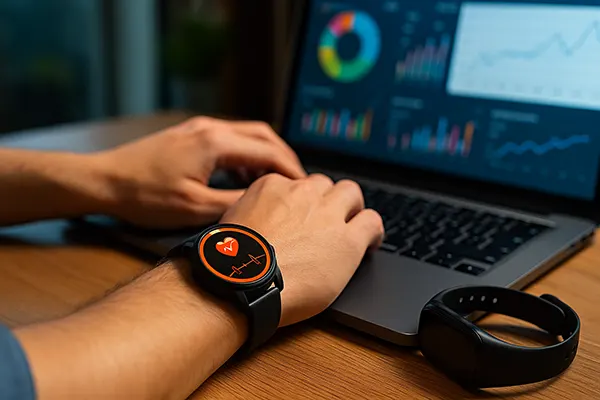
Marketing with Data from Wearables: How Brands Work with Smartwatches and Fitness Trackers
Wearable technology has become one of the most significant sources of consumer insights in 2025. Devices such as smartwatches and fitness trackers are not only helping people monitor their health but are also creating new opportunities for brands. By collecting and analysing this data responsibly, companies can improve their marketing strategies, personalise customer experiences, and foster stronger brand loyalty. However, the use of such sensitive data also raises ethical considerations that cannot be ignored.
Wearables as a Source of Consumer Data
Smartwatches and fitness trackers generate vast amounts of data every day. This includes information about physical activity, heart rate, sleep quality, stress levels, and even geographical movement. For marketers, these insights provide a window into consumers’ lifestyles, routines, and preferences. Understanding how individuals use their time and what habits they follow helps brands tailor campaigns with higher accuracy.
Retailers, for example, are now exploring how activity data can inform personalised offers. A sportswear company might identify customers who frequently run long distances and send them promotions on advanced running shoes or performance clothing. Similarly, food delivery services can adapt suggestions based on patterns of calorie expenditure tracked by wearables.
In addition, the continuous nature of data collection from wearables allows for real-time engagement. Instead of static campaigns, brands can deliver dynamic recommendations based on what a person is doing at the moment, such as suggesting hydration products after a workout session.
Opportunities and Risks for Marketers
The commercial potential of wearable data is enormous. By leveraging advanced analytics, companies can go beyond traditional demographics and understand the behavioural context of their customers. This enables more relevant product positioning and service design. For instance, insurers are offering discounts to clients who achieve certain fitness targets tracked through wearable devices, aligning business goals with healthier lifestyles.
Yet, with opportunity comes risk. Wearable data often falls into the category of sensitive health-related information. Mismanagement or misuse of such data can lead to breaches of trust and legal consequences. Consumers are increasingly aware of privacy issues, and regulatory frameworks in Europe and beyond are becoming stricter about how this type of data can be collected and used.
Marketers must therefore approach wearable-based campaigns with transparency. Clear communication about what data is being used, why it is needed, and how it benefits the consumer is essential. Without this trust, even the most innovative strategies will struggle to gain acceptance.
Personalisation Through Wearable Data
Personalisation has long been a priority in marketing, but wearable data has pushed it to an entirely new level. Unlike online browsing or purchase history, health and activity data reveal a deeper layer of consumer behaviour. Brands can use these insights to design more meaningful customer journeys.
For example, a wellness app may recommend meditation exercises based on the user’s stress data gathered from a smartwatch. Similarly, a travel company can suggest relaxation packages to individuals who show consistent signs of fatigue. The key is that the recommendations are not random but grounded in real-time personal data.
This form of personalisation is more likely to resonate with consumers because it demonstrates that the brand understands their individual needs. At the same time, it requires careful balance: overly intrusive marketing can backfire if users feel monitored rather than supported.
Examples of Brand Applications
Sports brands remain at the forefront of wearable-driven marketing. Nike and Adidas, for instance, are enhancing their mobile apps with wearable integration to provide training programmes tailored to the user’s activity levels. These recommendations not only encourage product purchases but also strengthen brand identity as a partner in personal improvement.
Healthcare and insurance companies are also heavily invested. By offering incentives for healthy behaviour, they can reduce risks and costs while motivating users to remain active. Similarly, hospitality businesses are experimenting with wellness-based offers, using wearable insights to promote spa treatments or fitness classes during a guest’s stay.
In retail, supermarkets are investigating the potential of linking wearable nutrition data with personalised discounts on healthy foods. This trend highlights the versatility of wearable-driven marketing across multiple sectors.

Ethical and Regulatory Considerations
As promising as wearable-based marketing appears, it cannot succeed without strong ethical foundations. Consumers must feel confident that their sensitive health and lifestyle data are handled with respect and in compliance with data protection laws. The General Data Protection Regulation (GDPR) in Europe sets strict standards, and similar legislation is emerging in other regions worldwide.
One of the central ethical principles is consent. Users need to actively agree to share their wearable data, and this consent should be informed and revocable at any time. Transparency about data storage, usage, and third-party access is equally crucial in building trust.
Moreover, brands should avoid over-reliance on wearable data in ways that may discriminate against or exclude certain groups. For example, not everyone has access to smartwatches or trackers, and basing marketing strategies solely on this data risks marginalising specific demographics.
Future Directions for Wearable Data Marketing
Looking ahead, wearable technology will continue to evolve, offering new dimensions of consumer insights. Devices are expected to include more advanced sensors capable of monitoring mental health, hydration levels, and other biological markers. This expansion will create fresh opportunities for brands to engage with their audiences in more targeted ways.
Artificial intelligence will play a key role in processing and interpreting the growing complexity of wearable data. AI-driven marketing tools will allow companies to detect subtle patterns and make predictive recommendations, further enhancing personalisation. However, this also amplifies the importance of ethical use and consumer protection.
Ultimately, success in this field will depend on striking a balance between innovation and responsibility. Brands that respect privacy while offering clear value will position themselves as trustworthy partners in the lives of their customers.

